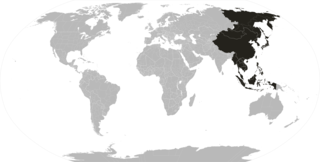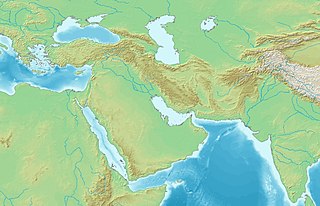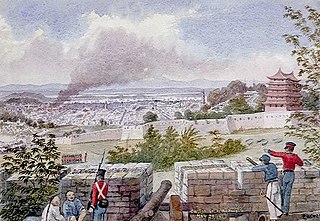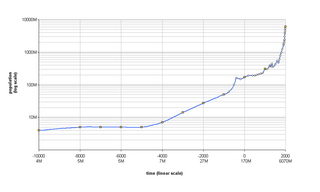This article does not cite any sources .(January 2007) (Learn how and when to remove this template message) |
The military history of Asia spans thousands of years.
This article does not cite any sources .(January 2007) (Learn how and when to remove this template message) |
The military history of Asia spans thousands of years.
| This Asian military article is a stub. You can help Wikipedia by expanding it. |

The earliest known written records of the history of China date from as early as 1250 BC, from the Shang dynasty, during the king Wu Ding's reign, who was mentioned as the twenty-first Shang king by the same. Ancient historical texts such as the Book of Documents, the Records of the Grand Historian and the Bamboo Annals mention and describe a Xia dynasty before the Shang, but no writing is known from the period, and Shang writings do not indicate the existence of the Xia. The Shang ruled in the Yellow River valley, which is commonly held to be the cradle of Chinese civilization. However, Neolithic civilizations originated at various cultural centers along both the Yellow River and Yangtze River. These Yellow River and Yangtze civilizations arose millennia before the Shang. With thousands of years of continuous history, China is one of the world's oldest civilizations, and is regarded as one of the cradles of civilization.

The Far East is a geographical region that includes the Russian Far East, Eastern and Southeastern Asia. South Asia is sometimes also included for economic and cultural reasons. The term "Far East" came into use in European geopolitical discourse in the 12th century, denoting the Far East as the "farthest" of the three "easts", beyond the Near East and the Middle East. Likewise, in Qing Dynasty of the 19th and early 20th centuries the term "Tàixī (泰西)" – i.e. anything further west than the Arab world – was used to refer to the Western countries.

The history of Asia can be seen as the collective history of several distinct peripheral coastal regions such as East Asia, South Asia, Southeast Asia and the Middle East linked by the interior mass of the Eurasian steppe. See History of the Middle East and Outline of South Asian history for further details.

Western imperialism in Asia involves the influence of people from Western Europe and associated states in Asian territories and waters. Much of this process stemmed from the 15th-century search for trade routes to China that led directly to the Age of Discovery, and the introduction of early modern warfare into what Europeans first called the East Indies and later the Far East. By the early 16th century, the Age of Sail greatly expanded Western European influence and development of the spice trade under colonialism. European-style colonial empires and imperialism operated in Asia throughout six centuries of colonialism, formally ending with the independence of the Portuguese Empire's last colony East Timor in 2002. The empires introduced Western concepts of nation and the multinational state. This article attempts to outline the consequent development of the Western concept of the nation state.

The History of East Asia encompasses the histories of China, Japan and Korea from prehistoric times to the present. East Asia is not uniform and each of its countries has a different national history, but scholars maintain that the region is also characterized by a distinct pattern of historical development. This is evident in the interrelationship among East Asian countries, which not only involve the sum total of historical patterns but also a specific set of patterns that has affected all or most of East Asia in successive layers.

Bactria, or Bactriana, was an ancient region in Central Asia. Bactria proper was north of the Hindu Kush mountain range and south of the Amu Darya river, covering the flat region that straddles modern-day Afghanistan, Tajikistan and Uzbekistan. More broadly Bactria was the area north of the Hindu Kush, west of the Pamirs and south of the Tian Shan, with the Amu Darya flowing west through the centre.

The Opium Wars were two wars waged between the Qing dynasty and Western powers in the mid-19th century. The First Opium War, fought in 1839–1842 between the Qing and the United Kingdom, was triggered by the dynasty's campaign against the Indian opium trade; the Second Opium War was fought between the Qing and Britain and France, 1856–1860. In each war, the European forces used recently developed military technology to defeat the Qing forces, and compelled the government to grant favorable tariffs, trade concessions, and territory.

Srivijaya was a Buddhist thalassocratic empire based on the island of Sumatra, Indonesia, which influenced much of Southeast Asia. Srivijaya was an important centre for the expansion of Buddhism from the 8th to the 12th century AD. Srivijaya was the first unified kingdom to dominate much of the Malay Archipelago. The rise of the Srivijayan Empire was parallel to the end of the Malay sea-faring period. Due to its location, this once-powerful state developed complex technology utilizing maritime resources. In addition, its economy became progressively reliant on the booming trade in the region, thus transforming it into a prestige goods-based economy.

Human history, also known as world history, is the description of humanity's past. It is informed by archaeology, anthropology, genetics, linguistics, and other disciplines; and, for periods since the invention of writing, by recorded history and by secondary sources and studies.

The history of Central Asia concerns the history of the various peoples that have inhabited Central Asia. The lifestyle of such people has been determined primarily by the area's climate and geography. The aridity of the region makes agriculture difficult and distance from the sea cut it off from much trade. Thus, few major cities developed in the region. Nomadic horse peoples of the steppe dominated the area for millennia.

Over the last four thousand years, Chinese imperialism has been a central feature of the history of East Asia. Since the recovery of Chinese strength in the late 20th century, the issues involved have been of concern to China's neighbors to the east.

The Mongol invasions and conquests took place during the 13th and 14th centuries, creating the vast Mongol Empire which by 1300 covered large parts of Eurasia. Historians regard the Mongol devastation as one of the deadliest episodes in history. In addition, Mongol expeditions may have spread the bubonic plague across much of Eurasia, helping to spark the Black Death of the 14th century.

The Yuan dynasty, officially the Great Yuan, was a successor state to the Mongol Empire after its division and a ruling dynasty of China established by Kublai Khan, leader of the Mongol Borjigin clan, lasting from 1271 to 1368. In Chinese historiography, this dynasty followed the Song dynasty and preceded the Ming dynasty.
The Xinhai Revolution in Xinjiang refers to the fightings of the members of Anti-Manchu Revolutionary Party (反清革命党人) in Xinjiang during the Xinhai Revolution. The Revolution mainly took place in Yili.
The military history of South Asia spans over thousands of years.

The Tang campaigns against the Western Turks, known as the Western Tujue in Chinese sources, were a series of military campaigns conducted during the Tang dynasty of China against the Western Turkic Khaganate in the 7th century AD. Early military conflicts were a result of the Tang interventions in the rivalry between the Western and Eastern Turks in order to weaken both. Under Emperor Taizong, campaigns were dispatched in the Western Regions against Gaochang in 640, Karasahr in 644 and 648, and Kucha in 648.

The Southward expansion of the Han dynasty was a series of Chinese military campaigns and expeditions in what is now modern Southern China and Northern Vietnam. Military expansion to the south began under the previous Qin dynasty and continued during the Han era. Campaigns were dispatched to conquer the Yue tribes, leading to the annexation of Minyue by the Han in 135 BC and 111 BC, Nanyue in 111 BC, and Dian in 109 BC.

The Han conquest of Dian was a series of military campaigns and expeditions by the Chinese Han dynasty recorded in contemporary textual sources against the Kingdom of Dian in modern Yunnan. Dian was placed under Han rule in 109 BC, after Emperor Han Wudi dispatched an army against the kingdom as the empire expanded southward.

The military of the Tang Dynasty was staffed with a large population of Turkic soldiers, referred to as Tujue in Chinese sources. Tang elites in northern China were familiar with Turkic culture, a factor that contributed to the Tang acceptance of Turkic recruits. The Tang emperor Taizong adopted the title of "Heavenly Kaghan" and promoted a cosmopolitan empire. Turkic soldiers that served under the Tang dynasty originated from the Eastern Turkic Khaganate. It began with Tang dynasty Emperor Taizong who sent his general Li Jing, eventually ended in defeating the Eastern Turks and capturing their leader Jiali Khan. Taizong regularly recruited and promoted military officers of Turkic ancestry, whose steppe experience contributed to the western and northern expansion of the Tang empire. The Turkic general Ashina She'er participated in the Tang capture of the Karakhoja, Karasahr, and Kucha kingdoms in Xinjiang. The half-Turkic general An Lushan started a revolt that led to the decline of Tang Dynasty.